Asphalt Tests
Kinematic Viscosity

The kinematic viscosity of a liquid is the absolute (or dynamic) viscosity divided by the density of the liquid at the temperature of measurement. The 135° C (275° F) measurement temperature was chosen to simulate the mixing and laydown temperatures typically encountered in HMA pavement construction.
read more ...Superpave Shear Tester
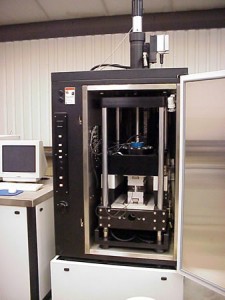
Overview The Superpave Shear Tester (SST) Figure 96) is used to characterize a HMA mixture’s resistance to permanent deformation (rut resistance). This characterization can be used as a performance test for HMA mixtures designed using Superpave mix design or other mix design procedures. The SST machine can perform several different tests to characterized HMA samples.
read more ...Absolute Viscosity

Viscosity is simply a measure of a fluid’s resistance to flow and is described by the following equation:
read more ...HMA Performance Tests
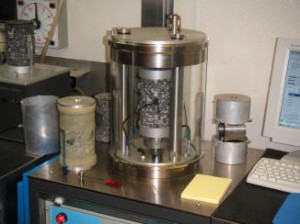
Performance tests are used to relate laboratory mix design to actual field performance. The Hveem (stabilometer) and Marshall (stability and flow) mix design methods use only one or two basic performance tests. Superpave is intended to use a better and more fundamental performance test.
read more ...Mixture Characterization Tests
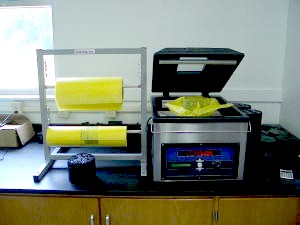
Mixture characterization tests are used to describe fundamental mixture parameters such as density and asphalt binder content. The three primary mixture characterization tests discussed here are:
read more ...Flash Point

A typical flash point test involves heating a small sample of asphalt binder in a test cup. The temperature of the sample is increased and at specified intervals a test flame is passed across the cup. The flash point is the lowest liquid temperature at which application of the test flame causes the vapors of the sample to ignite. The test can be continued up to the fire point – the point at which the test flame causes the sample to ignite and remain burning for at least 5 seconds.
read more ...Asphalt Mixture Performance Test

Overview The asphalt mixture performance tester (AMPT) is the companion performance test for use with the Superpave mix design procedure. Although the original SHRP asphalt research program was essentially done by 1993, it did not include a performance test for use with the rest of the Superpave mix design procedure.
read more ...Binder Content
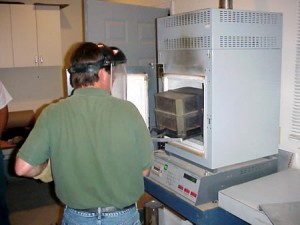
Overview Asphalt binder content affects HMA mixture performance in the areas of stiffness, strength, durability, fatigue life, raveling, rutting and moisture damage. Therefore, it is important in HMA quality assurance, pavement forensic investigations and HMA research.
read more ...Bulk Specific Gravity
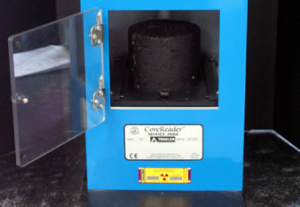
Overview The bulk specific gravity test is used to determine the specific gravity of a compacted HMA sample by determining the ratio of its weight to the weight of an equal volume of water.
read more ...Laboratory Wheel Tracking Devices
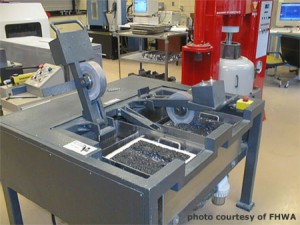
Overview Laboratory wheel-tracking devices (Figure 138) are used to run simulative tests that measure HMA qualities by rolling a small loaded wheel device repeatedly across a prepared HMA specimen. Performance of the test specimen is then correlated to actual in-service pavement performance. Laboratory wheel-tracking devices can be used to make rutting, fatigue, moisture susceptibility and stripping predictions. Some of these devices are relatively new and some have been used for upwards of 15 years like the French Rutting Tester (FRT).
read more ...Moisture Susceptibility

Moisture susceptibility is a primary cause of distress in HMA pavements. HMA should not degrade substantially from moisture penetration into the mix. HMA mixtures may be considered susceptible to moisture if the internal asphalt binder-to-aggregate bond weakens in the presence of water. This weakening, if severe enough, can result in stripping (Figure 147).
read more ...Theoretical Maximum Specific Gravity
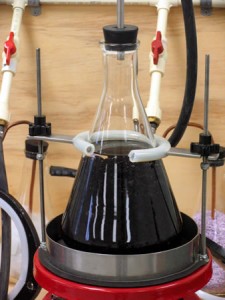
Overview The theoretical maximum specific gravity (Gmm) of a HMA mixture is the specific gravity excluding air voids. Thus, theoretically, if all the air voids were eliminated from an HMA sample, the combined specific gravity of the remaining aggregate and asphalt binder would be the theoretical maximum specific gravity. Theoretical maximum specific gravity can be multiplied by the density of water (62.4 lb/ft3 or 1000 g/L) to obtain a theoretical maximum density (TMD) or “Rice” density (named after James Rice, who developed the test procedure).
read more ...